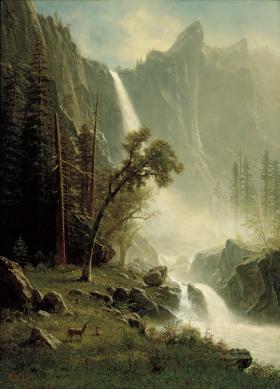1. Assign the class to examine Bridal Veil Falls, Yosemite. Have students compare the image to a current photograph of the site. http://en.wikipedia.org/wiki/Bridalveil_Fall
Ask students to consider how accurately Bierstadt portrayed what he saw.
2. Hold a brief class discussion focused on the following question: Why might some 19th-century New Yorkers, upon first seeing this painting, think it was just a figment of the artist's imagination?
3. Assign each student to read the description of western photographers "People and Events: Photographing the American Wilderness."
4. Ask each student to respond YES or NO on a small sheet of paper to the following question: Do you think a photograph tells the truth?
Collect the responses and tabulate the results of the poll on the board. While looking at the class results, hold a brief whole-class discussion focused on the following question: Why did you vote the way you did? Some discussion should focus on objectivity versus subjectivity. Photographs, like other art forms, are subjective, although they might appear to be purely objective.
5. Write the results of the Internet poll conducted in conjunction with the PBS presentation Ansel Adams: A Documentary Film on the board, or show results to the class by going to the poll results Web site. Hold a brief class discussion focused on comparing the class results with the Internet poll results.
6. Continue the class discussion by asking students to consider the poll results when responding to the following question: Were photographs necessary to convince easterners of the grandeur (and the reality) of the American West? Why or why not?
7. Divide the class into pairs of students. Provide each pair of students with a copy of the attached Image Analysis Chart. Assign each pair of students to examine five additional images, two Bierstadt paintings of California:
and three Adams photographs of the West:
- Lakes and Cliffs, Sierra Nevada, 1932
- Winter Sunrise, Sierra Nevada, from Lone Pine, California, 1944
- Moonrise, Hernandez, New Mexico, 1941
Ask each pair of students to record their observations on the Image Analysis Chart.
8. Hold a class discussion focused on the following question: Which images seem more accurate in depicting the western landscape, the Bierstadt painting or the Adams photographs? Why?
9. Assign each student to write a one-page essay assessing the validity of the following statement: Photographs should be considered fine art and treated just like paintings.
Have students draw on impressions of the Bierstadt paintings and Adams photographs to support their arguments. Students should be referred to the excerpt from Andy Grundberg's Crisis of the Real, Writings on Photography since 1974 titled "Art or Document?"
- Class discussion, the poll, Image Analysis Chart, and essay will be used to evaluate the students’ understanding of the role of American painters and photographers in the idealization of the American West and how these images helped to influence the western pattern of migration.
- The essay will be used to assess each student’s ability to formulate historical questions and evaluate competing narratives.
- The Image Analysis Chart, class discussion, and essay will be used to assess the students’ analysis of realism, symbolism, and composition in painting and photography.
composition
grandeur
idealization
idealizing
mood
objective
objectivity
realism
setting
subject
subjective
subjectivity
symbolism
Albert Bierstadt, Looking Up the Yosemite Valley, about 1863–1875
Ansel Adams's photographs:
Lakes and Cliffs, Sierra Nevada, 1932
Winter Sunrise, Sierra Nevada, from Lone Pine, California, 1944
Moonrise, Hernandez, New Mexico, 1941
Online poll results for the question, "Do you think a photograph tells the truth?"
Excerpt "Art or Document?" from Andy Grundberg's Crisis of the Real, Writings on Photography since 1974
German-born Albert Bierstadt gave definitive expression to America's westward expansionism in the 1860s and 1870s. His vast panoramas of the Rockies and Sierra Nevadas, their skies often turbulent and shot through with sunlight, introduced Americans to a majestic wilderness, awesome but unthreatening, and well worth possessing. In a sense, the artist staked claim to the land by painting it, then passed ownership on to the viewer.
Bierstadt found his greatest subject in California's Yosemite Valley, which he first visited in the summer of 1863. So spectacular was the remote and secluded valley that early visitors readily imagined it the Promised Land.
Bierstadt's many paintings of Yosemite are indeed biblical in their grandeur, imbued with the sense that divinity dwelled within the wilderness. This painting, probably dating from the artist's return to the valley in 1872, depicts the aptly named Bridal Veil Falls, one of Yosemite's celebrated natural wonders. A companion of Bierstadt wrote that the falls "might well seem the veil worn by the earth at her granite wedding."


